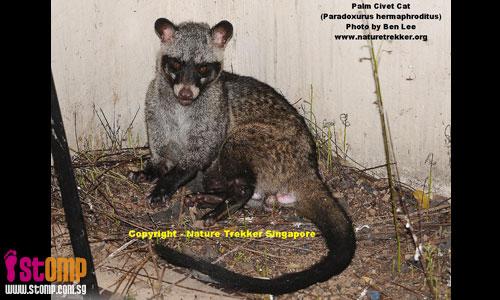
This Palm Civet, a native wild animal of Singapore, was found hiding in the backyard of a resident who lives at Kembangan. Nature Trekker Singapore, a non-profit organisation, says that the public should inform relevant authorities such as AVA, Nparks or them if they come across similar sightings.
Nature Trekker Singapore went down to Kembangan and saw this Palm Civet, but the animal ran off soon after these pictures were taken.
An administrator for the organisation says:
"Ben Lee, the founder and head of Nature Trekker Singapore received a tip-off on Jun 3, of a fox-like animal found hiding inside the backyard of a private resident along Eunos/Kembangan area.
"Upon receiving the call, Mr Lee sprang into action and drove straight down to the resident to investigate.
"To his utmost surprise, he immediately confirmed the animal reported was indeed an elusive Common Palm Civet (Paradoxurus hermaphroditus), a native wild animal of Singapore.
"The wild animal eventually ran off by climbing over a tall tree in the backyard and leaped over the house parapet as it felt the presence of Mr Lee taking its pictures, and the resident.
"According to him, this extremely elusive wild animal is a nocturnal forest dweller and by nature, it is frugivorous and omnivorous.
"It spends most of its time on trees and not on ground hence in essence, it is an aboreal creature.
"It can be found in many forests especially those in Bukit Timah, Central Catchment, Pulau Ubin and Pulau Tekong.
"Some people call it 'Toddy Cat' or 'Musang'. It can grow to a size of a large cat and it has a long tail. A fully grown adult Palm Civet can grow up to 137cm measuring from the tip of its tail to the nose.
"Mr Lee believes the presence of the elusive wild civet in urban areas is due to the dwindling forests in Singapore.
"The public is advised not to harm or kill such animals as it is against the law to kill wild animals in Singapore even if they were to be found in urban residents' backyards or gardens.
"This animal is completely harmless and shy in nature. It will never attack humans unless provoked, which is a natural survival instinct for most animals, even for domestic dogs and cats.
"The civet cats' first instinct if they come face to face with a human is to run or escape, which is why this animal is very rarely seen by people.
"Most Singaporeans would not imagine that there is still such wild Palm Civets exist in Singapore.
"Although the name 'Common' is used for the species, in reality it is not common and not easy to encounter a palm civet in the wild.
"The public should report any sightings like these to the relevant authorities such as AVA, Nature Trekker Singapore or Nparks."
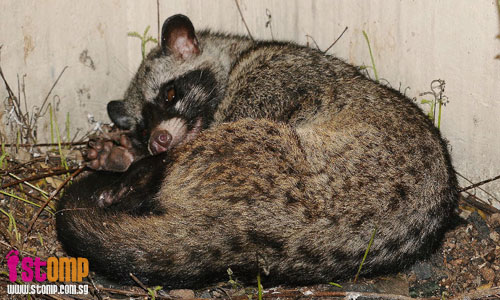
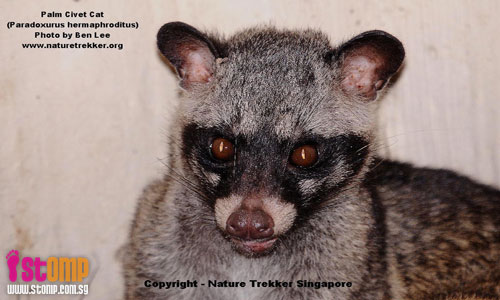

Related article: Civet cats on Tanglin Halt tree? Look again
Here's an interesting record of the common palm civet (Paradoxurus hermaphroditus). Although I did spot one in the Maliau Basin in Sabah, I've yet to encounter a common palm civet in Singapore. I have however seen civet droppings at Chek Jawa on several occasions.
Because it is a rather shy creature, not many Singaporeans are aware that common palm civets are actually quite widespread in Singapore after all. The common palm civet is a relatively adaptable species, and not only does it live in forests, scrubland, and mangroves, it can also be found inhabiting urban areas of Singapore. According to Wild Animals of Singapore, they are known to frequent gardens and roof spaces of buildings.
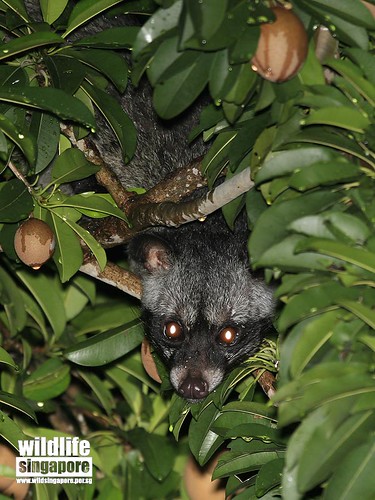
Common palm civet in chiku (Manilkara zapota) tree;
(Photo by kwokwai76)
This carnivore is predominantly frugivorous, and may become a pest in fruit orchards and plantations. Its fondness for fruit has also led to its legendary role in the production of kopi luwak.
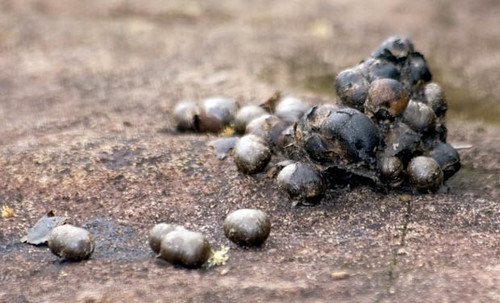
Common palm civet droppings, Pulau Ubin;
(Photo by Marcus)
The name of 'toddy cat' stems from the common palm civet's fondness for palm sap, which is often collected by people and allowed to ferment, creating the alcoholic beverage known as toddy.
Despite feeding largely on fruit, the common palm civet still retains some carnivorous tendencies, and will feed on insects, eggs, reptiles, birds, and rodents. It is also known to raid chicken coops.

Common palm civet, Chek Jawa;
(Photo by Ria)
The common palm civet is featured on the logo of the Raffles Museum of Biodiversity Research.

While the volunteers with the museum are known as the Toddycats!, with a cute and eye-catching mascot.

Among the 8 species of civet recorded from Singapore, only the common palm civet is considered to be relatively widespread and common. 1 other species, the small-toothed palm civet (Arctogalidia trivirgata), is confined to the forests of the Central Nature Reserves.
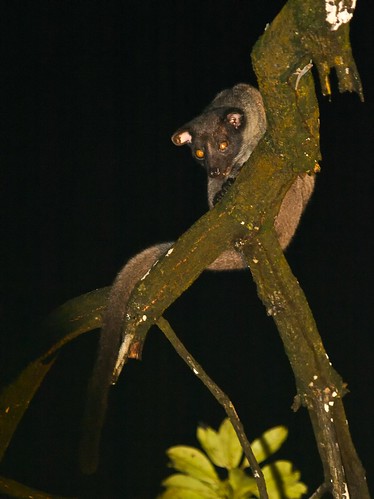
Small-toothed palm civet, Sabah;
(Photo by RON PUDIN)
The masked palm civet (Paguma larvata) may still survive in our forests, although it is possible that it is already locally extinct.

Masked palm civet, Zoo Melaka;
(Photo by Pierre de Chabannes)
The binturong (Arctictis binturong), largest of the palm civets, is most likely extinct in Singapore, although according to the Straits Times, an individual was found and captured in the Bukit Panjang area in 2004. I'm wondering if it was an escapee from captivity, or a bona fide wild binturong; certainly, the close proximity to the forests of the Central Nature Reserves means that we cannot rule out that there might still be binturong hiding in our forests. I'm a little surprised that there isn't more discussion over this find. Is there anyone who knows more about this discovery, and whether it was eventually determined to be a wild or escaped binturong?
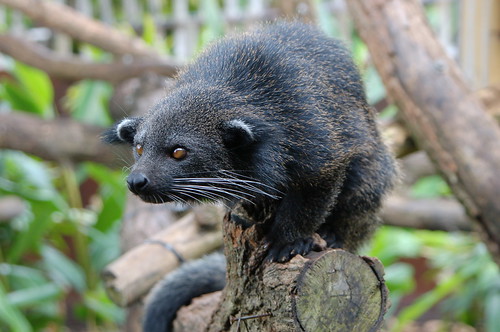
Binturong, Taronga Zoo;
(Photo by jennifernasim)
Unlike the palm civets, other civet species are more terrestrial and carnivorous. The status of the large Indian civet (Viverra zibetha) and Malay civet (Viverra tangalunga) in Singapore is Indeterminate; they are either already extinct or nearly so.


Left: Large Indian civet, Zoo Melaka;
(Photo by Pierre de Chabannes)
Right: Malay civet, Sabah;
(Photo by Johnnizam)
Same goes for the small Indian civet (Viverricula indica); it's listed as Indeterminate in Wild Animals of Singapore, but is probably extinct here.

Small Indian civet;
(Photo from Mammalogical Society of Taiwan)
It is doubtful that the large-spotted civet (Viverra megaspila) and otter civet (Cynogale bennettii) ever existed here in recent history; old records of these species from Singapore are likely to be erroneous.


Left: Large-spotted civet;
Right: Otter civet;
(Photos from Animal Info)
Some of these civet species can be seen at the Singapore Zoo and Night Safari; if I recall correctly, on my last visit, binturong could be seen at both the Singapore Zoo and Night Safari, while the Night Safari had a mixed-species exhibit where both small-toothed palm civet and Malay civet were on display.
I could go on and talk about the mistaken link between civets and SARS, or how civets contribute to the perfume industry, or how various carnivores once thought to be civets aren't actually civets, but that's best reserved for another post.